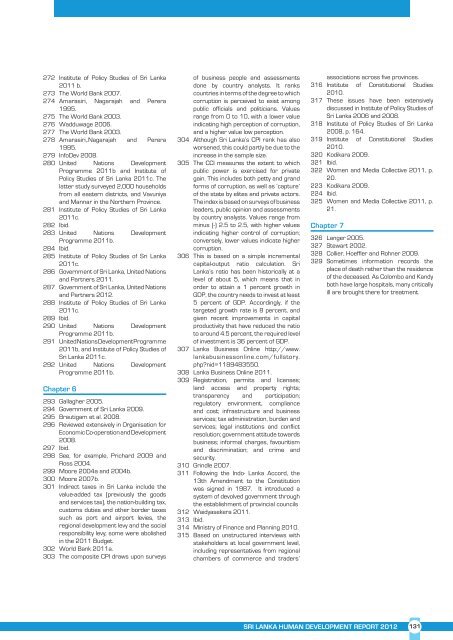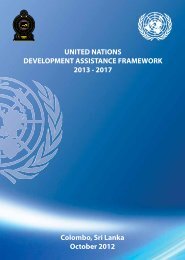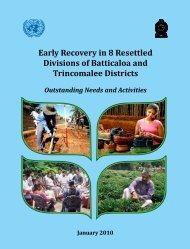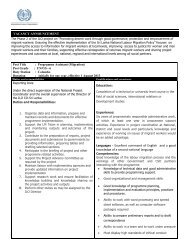Sri Lanka Human Development Report 2012.pdf
Sri Lanka Human Development Report 2012.pdf
Sri Lanka Human Development Report 2012.pdf
Create successful ePaper yourself
Turn your PDF publications into a flip-book with our unique Google optimized e-Paper software.
272 Institute of Policy Studies of <strong>Sri</strong> <strong>Lanka</strong><br />
2011 b.<br />
273 The World Bank 2007.<br />
274 Amarasiri, Nagarajah and Perera<br />
1995.<br />
275 The World Bank 2003.<br />
276 Wadduwage 2006.<br />
277 The World Bank 2003.<br />
278 Amarasiri,.Nagarajah and Perera<br />
1995.<br />
279 InfoDev 2008.<br />
280 United Nations <strong>Development</strong><br />
Programme 2011b and Institute of<br />
Policy Studies of <strong>Sri</strong> <strong>Lanka</strong> 2011c. The<br />
latter study surveyed 2,000 households<br />
from all eastern districts, and Vavuniya<br />
and Mannar in the Northern Province.<br />
281 Institute of Policy Studies of <strong>Sri</strong> <strong>Lanka</strong><br />
2011c.<br />
282 Ibid.<br />
283 United Nations <strong>Development</strong><br />
Programme 2011b.<br />
284 Ibid.<br />
285 Institute of Policy Studies of <strong>Sri</strong> <strong>Lanka</strong><br />
2011c.<br />
286 Government of <strong>Sri</strong> <strong>Lanka</strong>, United Nations<br />
and Partners 2011.<br />
287 Government of <strong>Sri</strong> <strong>Lanka</strong>, United Nations<br />
and Partners 2012.<br />
288 Institute of Policy Studies of <strong>Sri</strong> <strong>Lanka</strong><br />
2011c.<br />
289 Ibid.<br />
290 United Nations <strong>Development</strong><br />
Programme 2011b.<br />
291 United Nations <strong>Development</strong> Programme<br />
2011b, and Institute of Policy Studies of<br />
<strong>Sri</strong> <strong>Lanka</strong> 2011c.<br />
292 United Nations <strong>Development</strong><br />
Programme 2011b.<br />
Chapter 6<br />
293 Gallagher 2005.<br />
294 Government of <strong>Sri</strong> <strong>Lanka</strong> 2009.<br />
295 Brautigam et al. 2008.<br />
296 Reviewed extensively in Organisation for<br />
Economic Co-operation and <strong>Development</strong><br />
2008.<br />
297 Ibid.<br />
298 See, for example, Prichard 2009 and<br />
Ross 2004.<br />
299 Moore 2004a and 2004b.<br />
300 Moore 2007b.<br />
301 Indirect taxes in <strong>Sri</strong> <strong>Lanka</strong> include the<br />
value-added tax (previously the goods<br />
and services tax), the nation-building tax,<br />
customs duties and other border taxes<br />
such as port and airport levies, the<br />
regional development levy and the social<br />
responsibility levy; some were abolished<br />
in the 2011 Budget.<br />
302 World Bank 2011a.<br />
303 The composite CPI draws upon surveys<br />
of business people and assessments<br />
done by country analysts. It ranks<br />
countries in terms of the degree to which<br />
corruption is perceived to exist among<br />
public officials and politicians. Values<br />
range from 0 to 10, with a lower value<br />
indicating high perception of corruption,<br />
and a higher value low perception.<br />
304 Although <strong>Sri</strong> <strong>Lanka</strong>’s CPI rank has also<br />
worsened, this could partly be due to the<br />
increase in the sample size.<br />
305 The CCI measures the extent to which<br />
public power is exercised for private<br />
gain. This includes both petty and grand<br />
forms of corruption, as well as ‘capture’<br />
of the state by elites and private actors.<br />
The index is based on surveys of business<br />
leaders, public opinion and assessments<br />
by country analysts. Values range from<br />
minus (-) 2.5 to 2.5, with higher values<br />
indicating higher control of corruption;<br />
conversely, lower values indicate higher<br />
corruption.<br />
306 This is based on a simple incremental<br />
capital-output ratio calculation. <strong>Sri</strong><br />
<strong>Lanka</strong>’s ratio has been historically at a<br />
level of about 5, which means that in<br />
order to attain a 1 percent growth in<br />
GDP, the country needs to invest at least<br />
5 percent of GDP. Accordingly, if the<br />
targeted growth rate is 8 percent, and<br />
given recent improvements in capital<br />
productivity that have reduced the ratio<br />
to around 4.5 percent, the required level<br />
of investment is 36 percent of GDP.<br />
307 <strong>Lanka</strong> Business Online http://www.<br />
lankabusinessonline.com/fullstory.<br />
phpnid=1189483550.<br />
308 <strong>Lanka</strong> Business Online 2011.<br />
309 Registration, permits and licenses;<br />
land access and property rights;<br />
transparency and participation;<br />
regulatory environment, compliance<br />
and cost; infrastructure and business<br />
services; tax administration, burden and<br />
services; legal institutions and conflict<br />
resolution; government attitude towards<br />
business; informal charges, favouritism<br />
and discrimination; and crime and<br />
security.<br />
310 Grindle 2007.<br />
311 Following the Indo- <strong>Lanka</strong> Accord, the<br />
13th Amendment to the Constitution<br />
was signed in 1987. It introduced a<br />
system of devolved government through<br />
the establishment of provincial councils<br />
312 Waidyasekera 2011.<br />
313 Ibid.<br />
314 Ministry of Finance and Planning 2010.<br />
315 Based on unstructured interviews with<br />
stakeholders at local government level,<br />
including representatives from regional<br />
chambers of commerce and traders’<br />
associations across five provinces.<br />
316 Institute of Constitutional Studies<br />
2010.<br />
317 These issues have been extensively<br />
discussed in Institute of Policy Studies of<br />
<strong>Sri</strong> <strong>Lanka</strong> 2006 and 2008.<br />
318 Institute of Policy Studies of <strong>Sri</strong> <strong>Lanka</strong><br />
2008, p. 164.<br />
319 Institute of Constitutional Studies<br />
2010.<br />
320 Kodikara 2009.<br />
321 Ibid.<br />
322 Women and Media Collective 2011, p.<br />
20.<br />
223 Kodikara 2009.<br />
224 Ibid.<br />
325 Women and Media Collective 2011, p.<br />
21.<br />
Chapter 7<br />
326 Langer 2005.<br />
327 Stewart 2002.<br />
328 Collier, Hoeffler and Rohner 2009.<br />
329 Sometimes information records the<br />
place of death rather than the residence<br />
of the deceased. As Colombo and Kandy<br />
both have large hospitals, many critically<br />
ill are brought there for treatment.<br />
sri lanka <strong>Human</strong> <strong>Development</strong> report 2012 131






